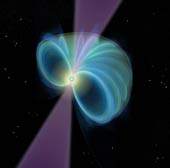New Kind of Cosmic Object Discovered
A multinational team of astronomers has discovered an entirely new kind of cosmic object. The small, highly compressed neutron stars, named Rotating Radio Transients (RRATs), are likely related to pulsars.
Neutron stars are the staggeringly dense cores of massive stars left behind after supernova explosions. The objects contain one and a half times the mass of our own sun packed into a space the size of a large city.
"These [new objects] are basically a new type of neutron star, but we're not exactly sure how they fit together with the other types," said astronomer Ingrid Stairs, of the University of British Columbia in Vancouver.
"They are clearly related to radio pulsars somehow, but we'll need more research [to understand the relation]."
Pulsars are neutron stars that spin about once a second and are often described as cosmic lighthouses. Their magnetic poles emit electromagnetic radio waves, so each time a pulsar spins, it sends out a radio blip.
But the RRATs' short, intermittent bursts are less frequent, spaced from four minutes to three hours apart.
"They're kind of like a flickering lighthouse, one where the power is going out on a regular basis," Stairs explained. "So instead of a blip every time it spins, there is one every few minutes or every few hours."
The RRAT radio waves were spotted using Australia's Parkes Radio Telescope. The find is reported in this week's issue of the journal Nature.
The objects could otherwise be normal pulsars that are less able to emit radio waves because of age, a different magnetic field structure, or some other unknown reason.
New Objects May Be Plentiful
Eleven RRATs have been identified so far, but researchers suggest that the new objects may far outnumber conventional radio pulsars.
"These things were very difficult to pin down," said Dick Manchester, a member of the research team and a scientist with the Australian Commonwealth Scientific and Industrial Research Organization.
"For each object, we've been detecting radio emission for less than one second a day."
Because the new objects are usually silent, the odds of spotting one are low. The identification of 11 RRATs therefore suggests that many more - perhaps several hundred thousand - are silently spinning in the galaxy.
Scientists are particularly interested in neutron stars because they offer a look at super high-density matter.
"Pulsars in many ways are the most extreme objects out there, next to black holes," Stairs, of the University of British Columbia, said.
"They have extreme conditions that you could never produce in a lab."
|
SOURCES AND RELATED WEB SITES
|



